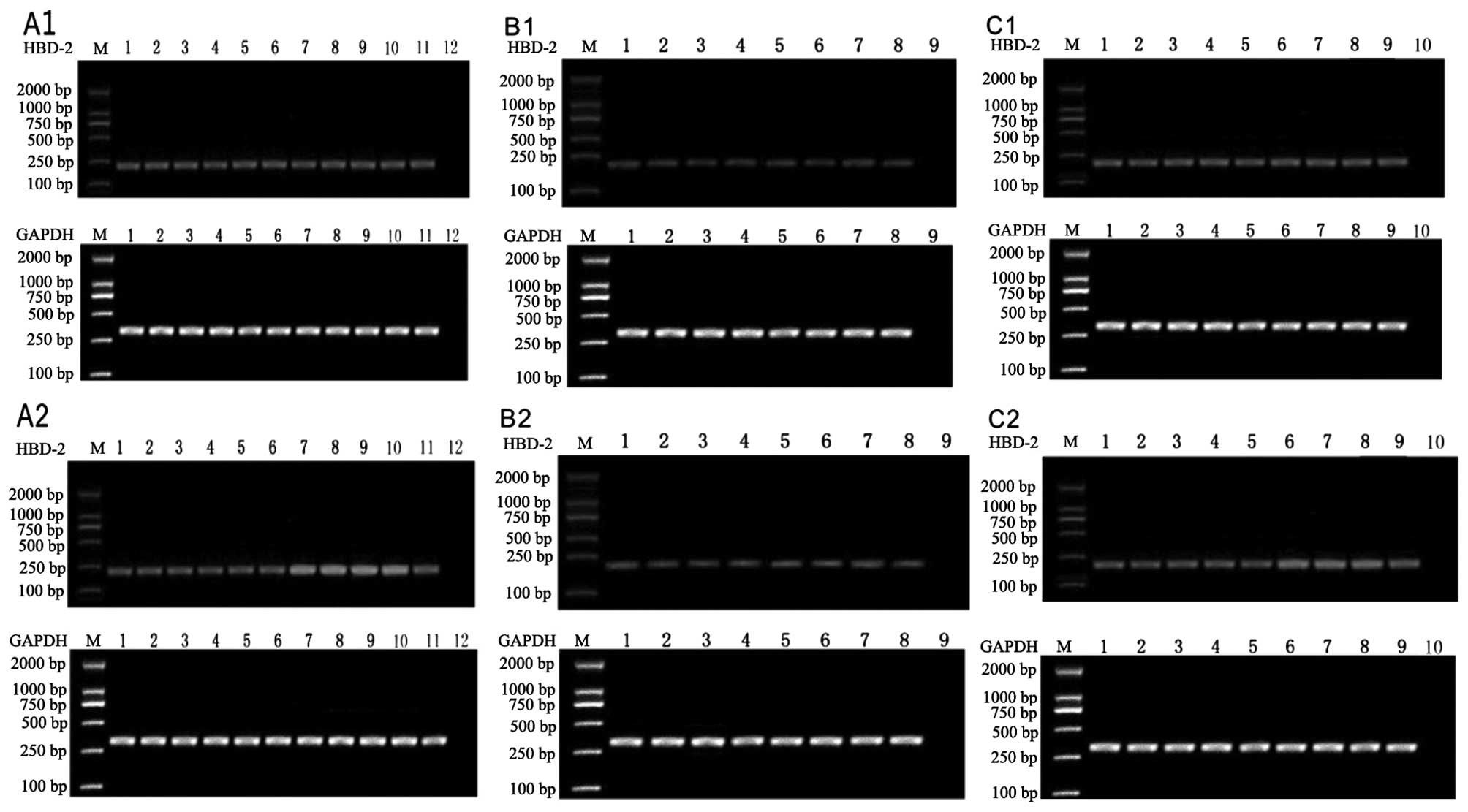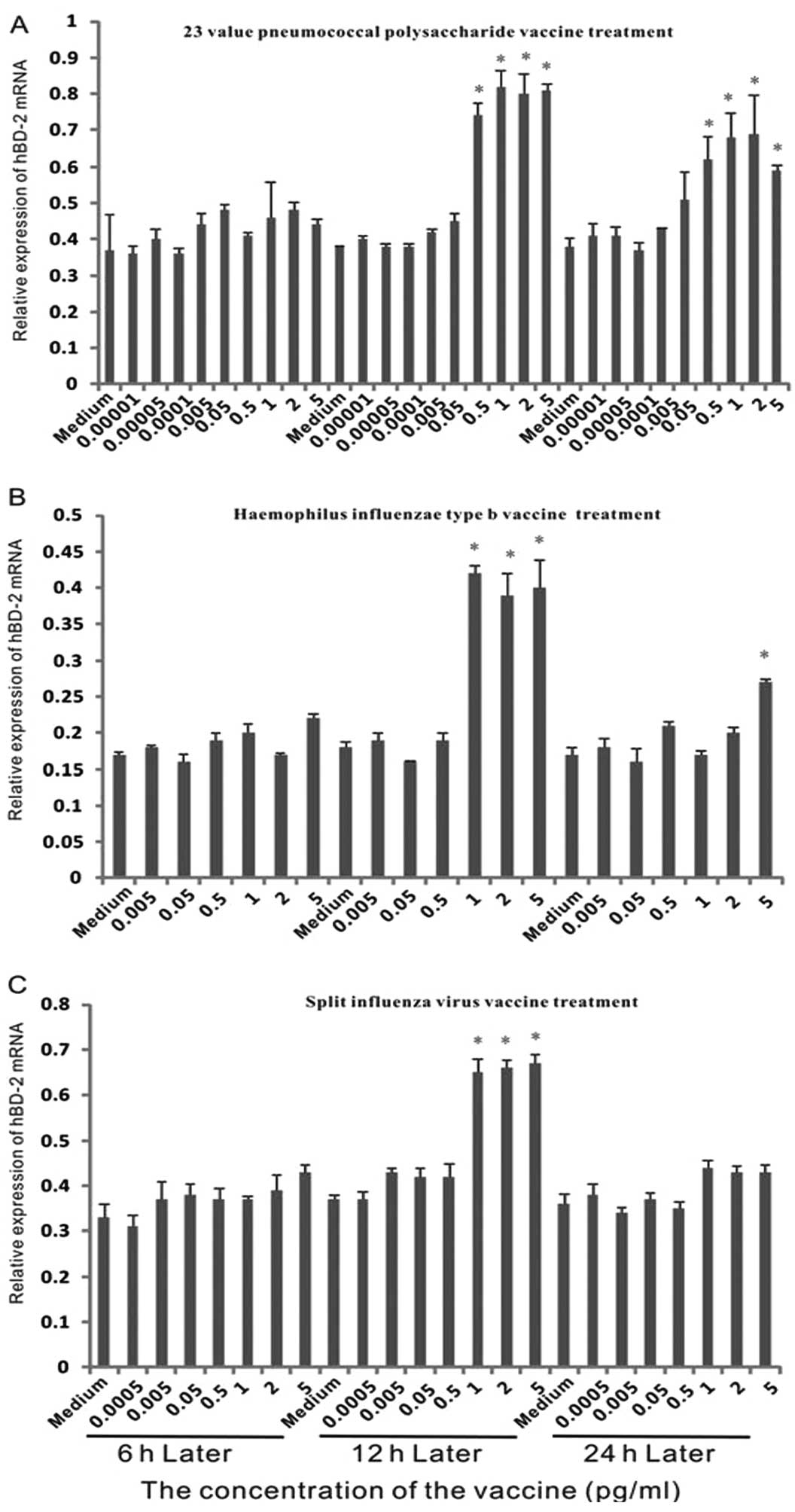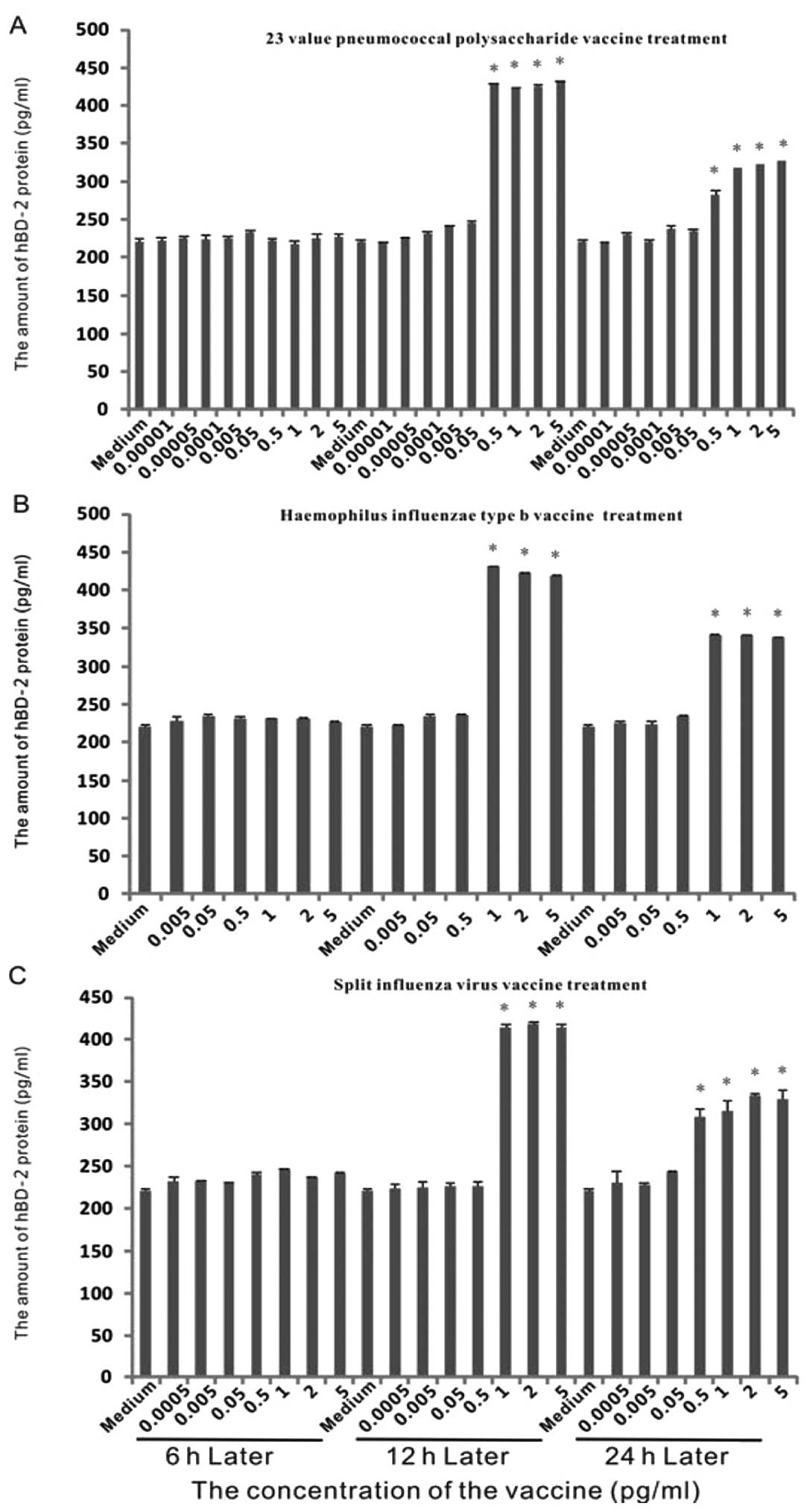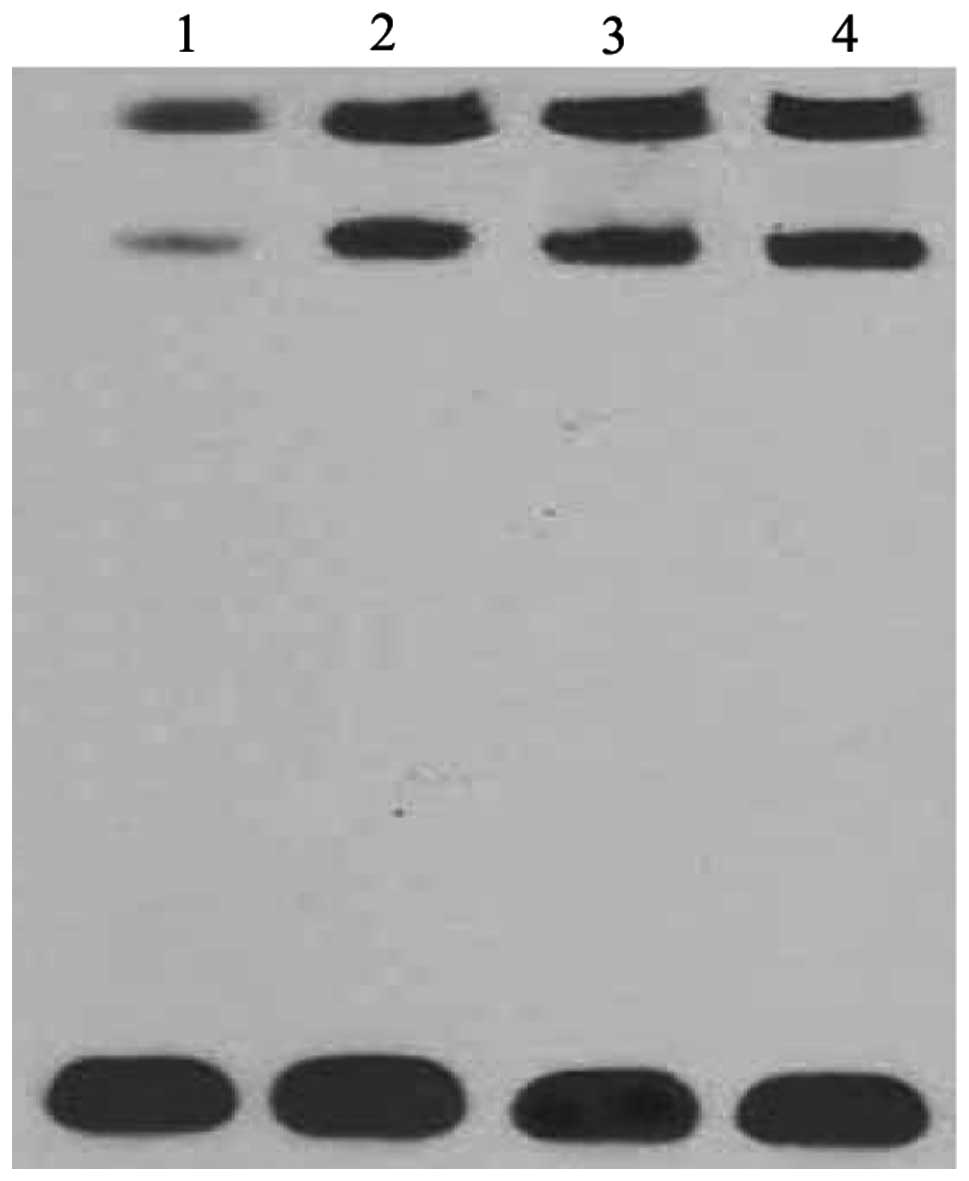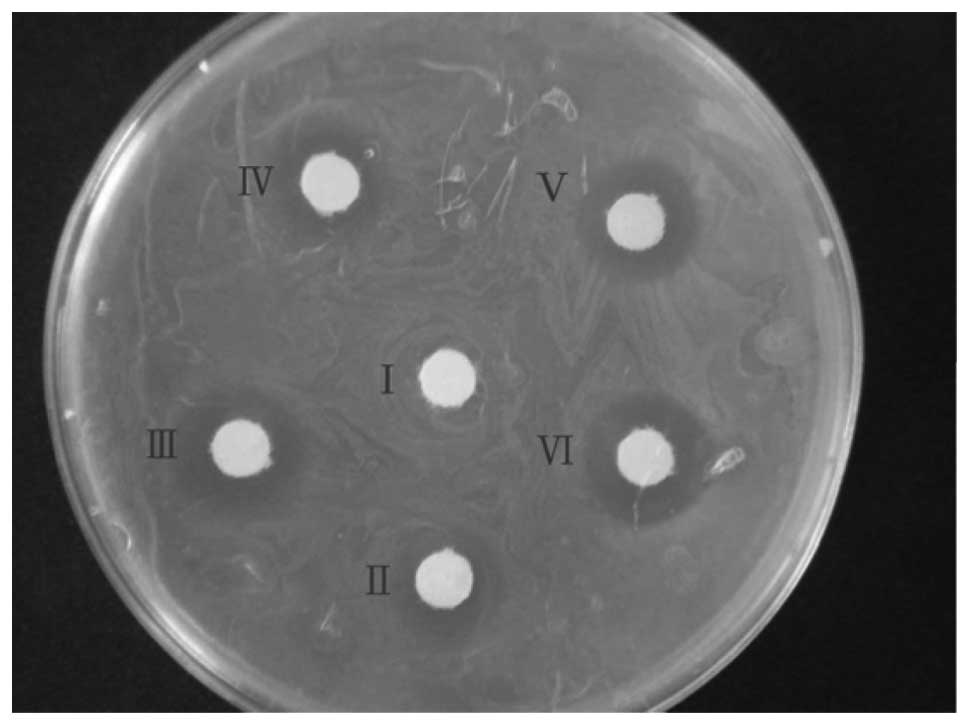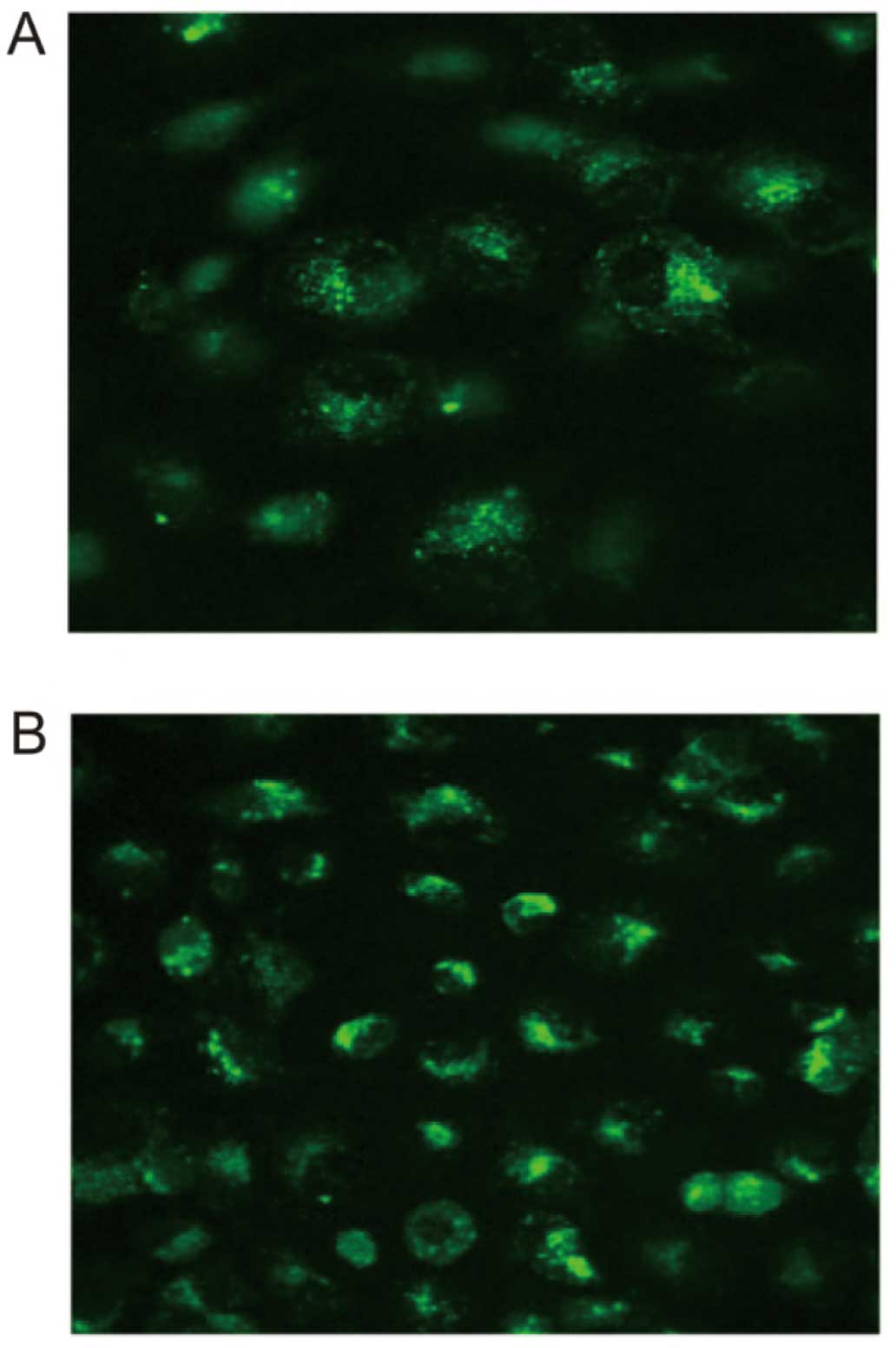Expression of hBD-2 induced by 23-valent pneumococcal polysaccharide vaccine, Haemophilus influenzae type b vaccine and split influenza virus vaccine
- Authors:
- Published online on: July 26, 2012 https://doi.org/10.3892/mmr.2012.1005
- Pages: 733-738
Abstract
Introduction
Human defensins are a group of antimicrobial peptides that defend hosts against bacterial, fungal and viral infections (1). Human β-defensins (hBDs) are a subfamily of defensins distributed at various mucosal surfaces (2). Although multiple gene duplications were observed in the human genome, only hBD-1, hBD-2, hBD-3 and hBD-4 have been described in detail to date (3). hBD-2 is the first member of the human defensin family that has been observed to be highly induced in inflamed epidermal cells, such as airway epithelia and in psoriasis (4,5). Previous studies had demonstrated that hBD-2 had high antimicrobial activity and broad spectrum activity (6,7).
The epithelial surface of the lungs is exposed to a large number of potentially pathogenic microorganisms. Several defence mechanisms are required to protect against infection. The production of antimicrobial peptides is one of the most important and evolutionarily conserved mechanisms. hBD-1 and hBD-2 were found to be locally expressed in the lung. Previous studies indicated that hBD-2 expression was induced by inflammation, whereas hBD-1 serves as a defense mechanism in the absence of inflammation (5,8). Furthermore, by measuring the concentration of hBD-2 in the bronchoalveolar lavage fluid of cystic fibrosis patients, the decrease of β-defensins in advanced lung disease was found to lead to a secondary defect of the local host defense (9). Hence, hBD-2 in the lung is likely to provide an effective shield from microbial infection.
hBD-2 exhibits particularly effective capacity against Gram-negative bacteria and certain fungi (7,10). Gram-negative bacteria, receiving notable concern in recent years, show the feature of using a plethora of mechanisms against antibiotics, which are due to gene cassettes and integrons (11,12). This feature makes them more resistant to antibiotics. While antibiotic resistance has become an increasing global problem, the discovery and development of new antibiotics has declined (13). Infections due to antibiotic-resistant bacteria cause a major public health dilemma, which may lead to future serious medical and social problems. Moreover, hospital-acquired infections have become a major threat to patient safety, and are associated with prolonged hospital stays, higher healthcare costs and increased mortality (14–16). The emergence of antibiotic-resistant infections mainly caused by Gram-negative bacteria aggravates the situation (14,15,17,18). Thus, in this study, we intend to elevate endogenous hBD-2 protein expression in order to meet the emerging clinical challenge.
Since the discovery of natural antimicrobial peptides, much research has been carried out to improve the innate immune response, including the study of many gene-based therapies (19–24). However, to date, all these methods are under preliminary investigation, and no new clinical application has been proposed. In this study, we found that killed vaccines, including the 23 valent pneumococcal polysaccharide vaccine, Haemophilus influenzae vaccine and split influenza virus vaccine, could serve as potential inducers of hBD-2. We propose that these vaccines, which already have proven biosafety records, may be used as a potential clinical approach.
Materials and methods
Primary cell culture and treatment
Human bronchial epithelia were surgically resected from patients without lung infection or tumors. The research was approved by the Ethics Committee of Tongji University, China. Primary tissues were digested by 0.125% trypsin with 0.01% EDTA, and cultured in Dulbecco’s modified Eagle’s medium/nutrient mixture F12 supplemented with 10% fetal bovine serum and 1% penicillin-streptomycin. For treatment, cells were plated in 6-well plates at a density of 1×105/well. Treatment with 23-valent pneumococcal polysaccharide vaccine, haemophilus influenzae type b vaccine or split influenza virus vaccine was performed after the cells reached ~80% confluence. Two independent experiments were performed and each experiment consisted of at least triplicate samples.
RNA extraction and semi-quantitative RT-PCR
Following treatment, cells were lysed with 1 ml of TRIzol reagent. Total RNA was extracted according to manufacturer’s instructions and dissolved in 30 μl H2O with DEPC. Total RNA (2 μg) was used for semi-quantitative RT-PCR according to the manufacturer’s instructions. GAPDH was selected as an internal control for normalization. For hBD-2 expression, the primers were designed according to the cDNA sequences (GeneBank accession no. NM_004942.2): the forward primer was 5′-CTT GTATCTCCTCTTCTCGTTCC-3′ and the reverse primer was 5′-TTTCTGAATCCGCATCAGC-3′. For GAPDH expression, the forward primer was 5′-GTCGGTGTGAACGGATTT-3′ and the reverse primer was 5′-ACTCCACGACGTACTC AGC-3′. cDNA (2 μl) was amplified for hBD-2 and GAPDH. PCR was performed in a 20-μl final volume containing 2 μl 10X reaction buffer, 0.2 mM dNTP, 2 mM MgCl2 and 1.5 units TaqDNA polymerase. The cycle numbers that generated approximately half maximal amplification were determined by testing different cycle numbers of amplification for each gene, and were found to be 40 cycles for hBD-2 and 30 cycles for GAPDH. The PCR conditions were 94°C for 15 sec, annealing at 61°C for hBD-2 and 57°C for GAPDH for 20 sec and extension at 72°C for 30 sec. The PCR product (5 μl) was checked on a 2.0% agarose gel and visualized using ethidium bromide staining with UV illumination. The intensity of each band was analyzed using the BioSenSC300 system.
Enzyme-linked immunosorbent assay
The medium was collected at 6 and 12 h following treatment. After centrifugation at 3000 g for 20 min, the supernatant samples were removed. The manufacturer’s instructions for enzyme-linked immunosorbent assay (ELISA) were followed. Briefly, the microtiter plates were coated by adding 100 μl of the samples. After 90 min incubation, the microtiter plates were agitated to remove the samples. Biotin-labeled antibody (100 μl) was added and the plates were then incubated at 37°C for 60 min. After three washing steps with 0.01 M PBS, the plates were filled with with 100 μl avidin-biotin-peroxidase complex at 37°C for 30 min. After extensive washing, the immunological reactions were revealed by 30-min incubation in the dark with 90 μl TMB Microwell substrate. TMB stop solution was added to stop the reaction. The optical density results were converted into concentrations deduced from a calibration curve.
Electrophoretic mobility shift assay (EMSA)
According to the core recognition site of NF-κB, the following oligonucleotides were synthesized for double-stranded probes: forward (5′-AGT TGA GGG GAC TTT CCC AGG C-3′) and reverse (3′-GCC TGG GAA AGT CCC CTC AAC T-5′). The annealed oligonucleotides were labeled with DIG dUTP by terminal transferase. The cellular extracts was incubated at room temperature for 20 min with 1 μg Poly(dI-dC) in a binding buffer containing 1X binding buffer, 2.5% glycerol, 0.05% NP-40, 100 mM MgCl2 and 20 fM biotin end-labeled target DNA. DNA-protein complexes were separated from free DNA by electrophoresis in a non-denaturing polyacrylamide gel at 4°C and electrophoretically transferred onto nylon membranes. The membranes were then dried in a drier at 70°C for 1 h and blocked with blocking buffer for 15 min. After extensive washing, the membranes were incubated with substrate equilibration buffer for 5 min; subsequently substrate working solution was added and the samples were incubated for another 5 min. Finally, images of the membranes were captured on film cassette following exposure to X-ray for 20 min.
Bacteriostatic experiment
The concentrated medium of cells treated with 23 valent pneumococcal polysaccharide vaccine, Haemophilus influenzae vaccine and split influenza virus vaccine were collected. The round filter paper was immersed in the medium, PBS and clean medium, respectively. The spread plate method was used to measure the antimicrobial activity.
Measurement of the concentration of Ca2+
Cells were plated in a 15×15-mm culture dish. After the cells reached ~90% confluence, the medium was replaced with D-Hanks buffer. An appropriate amount of Fluo-3/AM was added into the buffer at a final concentration of 5–10 μmol/l and incubated with the cells at 37°C in a 5% CO2 atmosphere for 60 min in the dark. Cells were then washed twice by PBS and once by D-Hanks buffer. Fluorescent images of the cells were visualized in D-Hanks buffer under a laser scanning confocal microscope at an excitation wavelength of 488 nm and an emission wavelength of 525 nm.
Statistical analyses
Data were presented as the means ± SD. Statistical analysis was performed using SPSS 11.0.0 (SPSS Inc., Chicago, IL, USA). Data were analyzed by one-way ANOVA followed by Dunnett’s multiple comparison test. P<0.05 was considered to indicate a statistically significant difference.
Results
Expression of hBD-2 mRNA in epithelial cells with various stimuli
To investigate the expression of hBD-2 mRNA in epithelial cells with different vaccine treatments, dose-effect experiments were performed (Fig. 1). As shown in Fig. 2, no marked upregulation was observed following 6 h of treatment. Another 6 h later, when the concentration of 23 valent pneumococcal polysaccharide vaccine was above 0.5 μg/ml, it enhanced the expression over 1.5-fold. The expression exhibited over 2-fold induction when cells were treated with greater than 1 μg/ml Haemophilus influenzae vaccine. For the split influenza virus vaccine, when the concentration was above 1 μg/ml, it stimulated the expression by greater than 1.5-fold.
At 24 h, the expression level of hBD-2 with 23 valent pneumococcal polysaccharide vaccine treatment was lower than at 12 h. In the Haemophilus influenzae vaccine treatment group, a significant difference was only observed at the concentration of 5 μg/ml. In the split influenza virus vaccine treatment group, no significant difference was detected. This indicated that the effect of vaccines on hBD-2 expression may be short-term.
Expression of hBD-2 protein in epithelial cells with various stimuli
To determine the concentration of protein, we performed ELISA with the medium of the dose-effect experiments mentioned previously (Fig. 3). After the first 6 h, no marked increase of protein occurred. Following 12 h of treatment, there was a ~2-fold induction by the 23 valent pneumococcal polysaccharide vaccine with concentrations of above 0.5 μg/ml. Similarly, a ~2-fold induction was observed when the Haemophilus influenzae vaccine or split influenza virus vaccine was used with concentrations above 1 μg/ml. At 24 h, the amount of hBD-2 protein was lower than at 12 h, but remained higher than that in the control group.
NF-κB involved in the signal pathway of vaccine-stimulation
Since NF-κB is a well-known mediator of induction of hBD-2 in epithelial cells, we tested the activity of the NF-κB subunit in normal epithelial cells and epithelial cells treated with the vaccines by EMSA (Fig. 4). Treatment with vaccines markedly increased the activity of the NF-κB subunit, while the activity of the NF-κB subunit was barely detected in normal epithelial cells.
Comparison of antimicrobial ability
To analyze the antimicrobial ability, concentrated medium was used for the bacteriostatic experiment (Fig. 5). The spots of inhibition were not clear for PBS and normal medium. The spot diameter was 12 mm with medium treated with 23 valent pneumococcal polysaccharide vaccine, 10 mm with medium treated with Haemophilus influenzae vaccine and 19 mm with medium treated with split influenza virus vaccine.
Discussion
In this study, we have used vaccines, including 23 valent pneumococcal polysaccharide vaccine, Haemophilus influenzae vaccine and influenza virus vaccine, to elevate the expression of hBD-2. The expression level of hBD-2 is markedly low in the absence of inflammation (8). In vivo, the vaccines may significantly induce the expression of hBD-2 within the first 12 h at an appropriate concentration. After 24 h, the expression of hBD-2 declined, but it remained significantly higher than the control group in the 23 valent pneumococcal polysaccharide vaccine treatment group and in the Haemophilus influenzae vaccine treatment group. This indicated that the effect of vaccines may be short-term.
Several microorganisms are capable of inducing the expression of certain defensins (25–27). Besides microorganisms, LTB4, L12, L23, L27 and certain other immune factors also induce the expression of hBD-2 (24,28). However, using these microorganisms to study the regulation and function in vivo and in vitro often leads to the threat of a biological hazard. Our results showed that vaccines could also serve as inducers of hBD-2, but with improved biosafety, simplicity and inexpensiveness. Hence, vaccines may be an alternative to the use of microorganisms and may facilitate the study of hBD-2.
Functional binding sites for NF-κB and AP-1 were identified in the promoter of hBD-2 (29–31). Besides these, little was known about the mechanism of induction of hBD-2. Multiple signaling pathways are involved in the inducible expression of hBD-2 (26). Hence, our study set up a biosecure model that facilitates the study of the mechanism of inducible expression in epithelial cells. As the NF-κB subunit was activated by the vaccines in our model, this indicated that our model could simulate the in vivo defense mechanism against microorganisms. Moreover, our preliminary results showed that vaccines could increase the concentration of Ca2+ within epithelial cells, which is in line with a previous study that proposes that the increase of Ca2+ is necessary for the activation of NF-κB (Fig. 6) (32).
During our investigation, the medium of split influenza virus vaccine treatment was revealed to have the highest antimicrobial activity with the least amount of hBD-2. Certain other antimicrobial peptides induced by the specific vaccine may contribute to the variation of the antimicrobial activity. The 23 valent pneumococcal polysaccharide vaccine was more sensitive to stimulating hBD-2 expression. Further research is required to explain the variation in innate immune response to exogenous stimulation.
Although the pharmaceutical industry endeavors to develop effective therapies against Gram-negative bacteria, it is difficult to meet the clinical challenge (33). hBD-2, with high antimicrobial activity against Gram-negative bacteria, is regarded as an approach to solve the problem. Thus, the effectiveness of vaccine-induced hBD-2 should be investigated in future studies.
Acknowledgements
This study was financially supported by the National Natural Science Foundation of China (No. 30670932), the Social Development Bureau Fund of Shanghai Municipal Pudong New District (No. pw2005A-10) and the Medicine Leading Talent Project Fund of Shanghai Municipal Pudong New District (CX2004004).
References
|
Lehrer RI: Primate defensins. Nat Rev Microbiol. 2:727–738. 2004. View Article : Google Scholar : PubMed/NCBI | |
|
Pazgier M, Hoover DM, Yang D, Lu W and Lubkowski J: Human beta-defensins. Cell Mol Life Sci. 63:1294–1313. 2006. View Article : Google Scholar | |
|
Rodriguez-Jimenez FJ, Krause A, Schulz S, et al: Distribution of new human beta-defensin genes clustered on chromosome 20 in functionally different segments of epididymis. Genomics. 81:175–183. 2003. View Article : Google Scholar : PubMed/NCBI | |
|
Schroder JM and Harder J: Human beta-defensin-2. Int J Biochem Cell Biol. 31:645–651. 1999. View Article : Google Scholar | |
|
Liu L, Wang L, Jia HP, et al: Structure and mapping of the human beta-defensin HBD-2 gene and its expression at sites of inflammation. Gene. 222:237–244. 1998. View Article : Google Scholar : PubMed/NCBI | |
|
Hiratsuka T, Nakazato M, Date Y, et al: Identification of human beta-defensin-2 in respiratory tract and plasma and its increase in bacterial pneumonia. Biochem Biophys Res Commun. 249:943–947. 1998. View Article : Google Scholar : PubMed/NCBI | |
|
Bals R, Wang X, Wu Z, et al: Human beta-defensin 2 is a salt-sensitive peptide antibiotic expressed in human lung. J Clin Invest. 102:874–880. 1998. View Article : Google Scholar : PubMed/NCBI | |
|
Singh PK, Jia HP, Wiles K, et al: Production of beta-defensins by human airway epithelia. Proc Natl Acad Sci USA. 95:14961–14966. 1998. View Article : Google Scholar : PubMed/NCBI | |
|
Chen CI, Schaller-Bals S, Paul KP, Wahn U and Bals R: Beta-defensins and LL-37 in bronchoalveolar lavage fluid of patients with cystic fibrosis. J Cyst Fibros. 3:45–50. 2004. View Article : Google Scholar : PubMed/NCBI | |
|
Harder J, Bartels J, Christophers E and Schröder JM: A peptide antibiotic from human skin. Nature. 387:8611997. View Article : Google Scholar : PubMed/NCBI | |
|
Hall RM and Collis CM: Antibiotic resistance in gram-negative bacteria: the role of gene cassettes and integrons. Drug Resist Updat. 1:109–119. 1998. View Article : Google Scholar : PubMed/NCBI | |
|
Partridge SR: Analysis of antibiotic resistance regions in Gram-negative bacteria. FEMS Microbiol Rev. 35:820–855. 2011. View Article : Google Scholar : PubMed/NCBI | |
|
Boucher HW, Talbot GH, Bradley JS, et al: Bad bugs, no drugs: no ESKAPE! An update from the Infectious Diseases Society of America. Clin Infect Dis. 48:1–12. 2009. | |
|
Slama TG: Gram-negative antibiotic resistance: there is a price to pay. Crit Care. 12(Suppl 4): S42008. View Article : Google Scholar : PubMed/NCBI | |
|
Peleg AY and Hooper DC: Hospital-acquired infections due to gram-negative bacteria. N Engl J Med. 362:1804–1813. 2010. View Article : Google Scholar : PubMed/NCBI | |
|
Mauldin PD, Salgado CD, Hansen IS, Durup DT and Bosso JA: Attributable hospital cost and length of stay associated with health care-associated infections caused by antibiotic-resistant gram-negative bacteria. Antimicrob Agents Chemother. 54:109–115. 2010. View Article : Google Scholar : PubMed/NCBI | |
|
Siegel RE: Emerging gram-negative antibiotic resistance: daunting challenges, declining sensitivities, and dire consequences. Respir Care. 53:471–479. 2008.PubMed/NCBI | |
|
Chopra I, Schofield C, Everett M, et al: Treatment of health-care-associated infections caused by Gram-negative bacteria: a consensus statement. Lancet Infect Dis. 8:133–139. 2008. View Article : Google Scholar : PubMed/NCBI | |
|
Xu B, Dong CY, Zhang F, Lin YM, Wu KF and Ma XT: Synergistic antileukemia effect of combinational gene therapy using murine beta-defensin 2 and IL-18 in L1210 murine leukemia model. Gene Ther. 14:1181–1187. 2007. View Article : Google Scholar : PubMed/NCBI | |
|
Yin C, Dang HN, Gazor F and Huang GT: Mouse salivary glands and human beta-defensin-2 as a study model for antimicrobial gene therapy: technical considerations. Int J Antimicrob Agents. 28:352–360. 2006. View Article : Google Scholar : PubMed/NCBI | |
|
Harvey SA, Romanowski EG, Yates KA and Gordon YJ: Adenovirus-directed ocular innate immunity: the role of conjunctival defensin-like chemokines (IP-10, I-TAC) and phagocytic human defensin-alpha. Invest Ophthalmol Vis Sci. 46:3657–3665. 2005. View Article : Google Scholar : PubMed/NCBI | |
|
Meyerholz DK, Grubor B, Gallup JM, et al: Adenovirus-mediated gene therapy enhances parainfluenza virus 3 infection in neonatal lambs. J Clin Microbiol. 42:4780–4787. 2004. View Article : Google Scholar : PubMed/NCBI | |
|
Bals R, Weiner DJ, Moscioni AD, Meegalla RL and Wilson JM: Augmentation of innate host defense by expression of a cathelicidin antimicrobial peptide. Infect Immun. 67:6084–6089. 1999.PubMed/NCBI | |
|
Gaudreault E and Gosselin J: Leukotriene B4 induces release of antimicrobial peptides in lungs of virally infected mice. J Immunol. 180:6211–6221. 2008. View Article : Google Scholar : PubMed/NCBI | |
|
Alekseeva L, Huet D, Femenia F, et al: Inducible expression of beta defensins by human respiratory epithelial cells exposed to Aspergillus fumigatus organisms. BMC Microbiol. 9:332009. View Article : Google Scholar : PubMed/NCBI | |
|
Krisanaprakornkit S, Kimball JR, Weinberg A, Darveau RP, Bainbridge BW and Dale DA: Inducible expression of human beta-defensin 2 by Fusobacterium nucleatum in oral epithelial cells: multiple signaling pathways and role of commensal bacteria in innate immunity and the epithelial barrier. Infect Immun. 68:2907–2915. 2000.PubMed/NCBI | |
|
Liu AY, Destoumieux D, Wong AV, et al: Human beta-defensin-2 production in keratinocytes is regulated by interleukin-1, bacteria, and the state of differentiation. J Invest Dermatol. 118:275–281. 2002. View Article : Google Scholar : PubMed/NCBI | |
|
Kanda N, Tada Y, Shimizu T and Watanabe S: IL-12, IL-23, and IL-27 enhance human beta-defensin-2 production in human keratinocytes. J Invest Dermatol. 38:1287–1296. 2008.PubMed/NCBI | |
|
Tsutsumi-Ishii Y and Nagaoka I: NF-kappa B-mediated transcriptional regulation of human beta-defensin-2 gene following lipopolysaccharide stimulation. J Leukoc Biol. 71:154–162. 2002.PubMed/NCBI | |
|
Yoon YM, Lee JY, Yoo D, et al: Bacteroides fragilis enterotoxin induces human beta-defensin-2 expression in intestinal epithelial cells via a mitogen-activated protein kinase/I kappa B kinase/NF-kappa B-dependent pathway. Infect Immun. 78:2024–2033. 2010. View Article : Google Scholar | |
|
Wehkamp J, Harder J, Wehkamp K, et al: NF-kappaB- and AP-1-mediated induction of human beta defensin-2 in intestinal epithelial cells by Escherichia coli Nissle 1917: a novel effect of a probiotic bacterium. Infect Immun. 72:5750–5758. 2004.PubMed/NCBI | |
|
Palkowitsch L, Marienfeld U, Brunner C, Eitelhuber A, Krappmann D and Marienfeld RB: The Ca2+-dependent phosphatase calcineurin controls the formation of the Carma1-Bcl10-Malt1 complex during T cell receptor-induced NF-kappaB activation. J Biol Chem. 286:7522–7534. 2011.PubMed/NCBI | |
|
Lavigne JP, Brunel JM, Chevalier J and Pages JM: Squalamine, an original chemosensitizer to combat antibiotic-resistant gram-negative bacteria. J Antimicrob Chemother. 65:799–801. 2010. View Article : Google Scholar : PubMed/NCBI |



